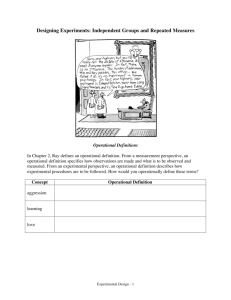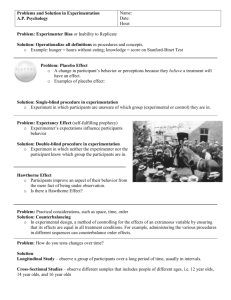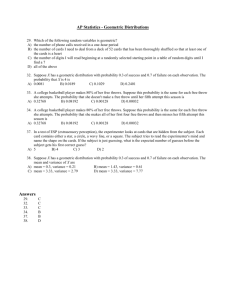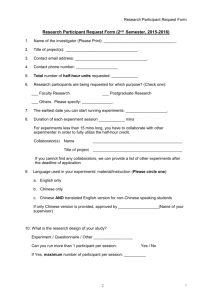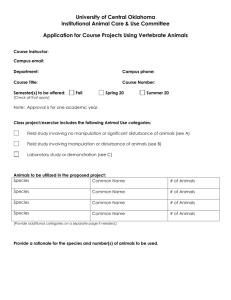Word
advertisement
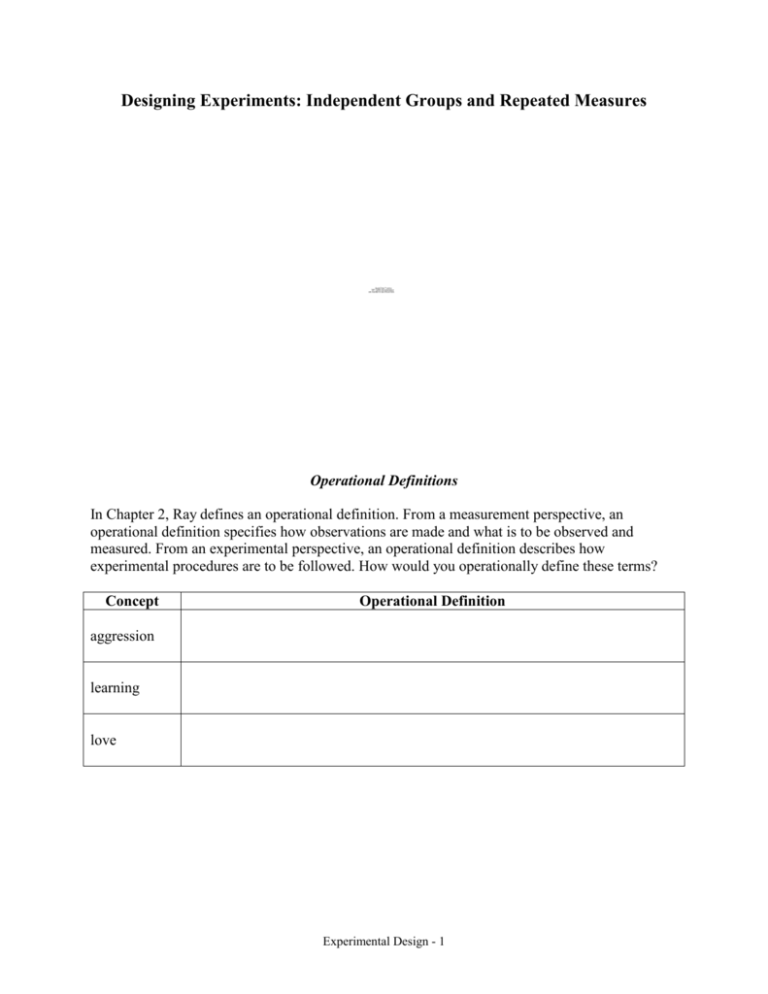
Designing Experiments: Independent Groups and Repeated Measures QuickTime™ and a TIFF (LZW) decompressor are needed to see this picture. Operational Definitions In Chapter 2, Ray defines an operational definition. From a measurement perspective, an operational definition specifies how observations are made and what is to be observed and measured. From an experimental perspective, an operational definition describes how experimental procedures are to be followed. How would you operationally define these terms? Concept Operational Definition aggression learning love Experimental Design - 1 2. Operational definitions are quite important because of the implications they have for both reliability and validity. Okay, so what are reliability and validity? How would an operational definition influence reliability and validity? Concept Definition reliability validity You may have already seen reliability and validity used in a number of different ways. What we’ll typically be talking about is construct-related validity. However, you may also want to consider predictive validity, content validity, and face validity. When talking about reliability, we’ll typically be talking about test-retest reliability. However, you may also want to consider inter-rater reliability. Independent and Dependent Variables Define an independent variable (IV). List at least 4 IVs that you know about from your reading in psychology (or that you could imagine). An important issue related to the independent variable is the concept of a manipulation check. You should consider introducing a manipulation check when your IV cannot be directly measured. For instance, if you’re using different levels of light (noise, shock, etc.) as your IV, there would be little reason for a manipulation check. However, if your IV is less tangible, a manipulation check may be in order. That is, suppose that you’re interested in pain as your IV. Although you could directly measure levels of shock, you can’t as readily measure levels of perceived pain. For that reason, you may decide to include a manipulation check when your IV is not directly measurable. You’d typically do so at the end of the study, with your manipulation check buried in a list of other questions so that your concerns are not so obvious. Experimental Design - 2 Define a dependent variable (DV). List at least 4 DVs that you know about from your reading in psychology (or that you could imagine). An issue that is related to both the IV and DV is the notion of a floor/ceiling effect. In any study, if people’s performance cannot vary (because the scores are all too low or too high), then you likely have a floor or ceiling effect. Should such a concern emerge, you’d have to re-design your study to eliminate the effect. Experimental Design - 3 Design an Independent Groups Experiment Suppose that you were interested in studying the effects of music on studying (for the purpose of retention of information). [This question is actually asked quite often.] Design a study with at least 3 levels of music (your IV). The nature of the questions you have may well lead to your choice of specific levels of your IV. What would you use as your DV? Think very carefully about specific operational definition(s). Provide a lot of detail about how you would conduct your study. Experimental Design - 4 Differences Between Independent Groups and Repeat Measures Designs We need to consider two different concepts: the effects of time and the role of individual differences. First, let’s consider the effects of time. Note that time can have an impact on both independent groups and repeated measures designs. The Effects of Time Independent Groups Design When running an experiment using an independent groups design, keep in mind that effects can arise over the course of the experiment. For instance, suppose that the experimenter starts out the study with all sorts of enthusiasm, but by the 300th participant is becoming a bit tired of the whole process. That experimenter might have an effect on the responses of the participants throughout the course of the study (positive at the beginning and negative toward the end). Likewise, imagine an experimenter who becomes increasingly adept at interacting with participants and at explaining the nature of the experiment. That experimenter will also have an effect of the responses of participants throughout the course of the study (negative at the beginning and positive at the end). In order to minimize the impact of such changes, you should collect data in such a way that a given condition of the experiment is as likely to occur early in the process of data collection as it is to occur late in the process. The best way to insure such balance is to run a participant in each condition of the experiment before running the next participant in any one condition. Typically, you would also vary the order in which you run the conditions. Such a process is referred to as running in randomized replications. For example, suppose that you had an independent groups design experiment with 4 levels (A, B, C, and D). Your first participant might be randomly assigned to level C, P2 to level B, P3 to level A and P4 to level D. In essence, you have run a complete mini-experiment. Your next four participants would also be randomly assigned to each of the four conditions (P5=A, P6=C, P7=D, P8=B). You would keep up this process until all participants were run. Repeated Measures Design When running an experiment using a dependent groups (repeated measures) design, you should keep in mind that there are effects that arise over the course of the experiment. In an independent groups design, a participant is exposed to only one level of the independent variable. In a repeated measures design, a participant is exposed to all levels of the independent variable. Because of that, carryover (order) effects are likely to occur in the participant’s responses. You cannot eliminate such effects in this type of experiment any more than one could eliminate the effects discussed above for independent groups designs. All that you can do, as above, is insure that the effects are spread out evenly over the conditions. The procedure for doing so is called counterbalancing. Generally, if you have a sufficiently small number of conditions, you would use complete counterbalancing. A completely counterbalanced experiment is one in which every possible ordering of the conditions is used in the experiment an equal number of times. For you combinations/permutations freaks, that would be k! combinations (where k is the number of conditions). Thus, with 2 conditions there would be only 2 unique orders (AB and BA). With 3 conditions, there would be 6 unique orders (ABC, ACB, BAC, BCA, CAB, CBA). With 4 conditions, there would be 24 unique orders, etc. You would have to run an equal number of Experimental Design - 5 participants in each order, so a completely counterbalanced repeated measures design for an experiment with 4 conditions would involve a minimum of 24 participants and could also involve 48, 72, 96, participants, etc. You could not have a completely counterbalanced repeated measures design for an experiment with 4 conditions and only have 32 participants...because some orders would be over-represented. How many participants would you need to completely counterbalance a repeated measures design with 5 conditions? With 6 conditions? With 7 conditions? (You would need 120, 720, and 5040 participants, respectively! As you can see, even with only 7 conditions, complete counterbalancing would require a substantial number of participants.) So suppose that you are not inclined to run so many participants. Is there some way around this problem? Well, it involves some compromise, but you could use an incomplete counterbalancing procedure. There are several different incomplete counterbalancing schemes, some of which are better than others. A simple Latin Square design is easy, but not particularly effective. For instance, suppose that you have 5 conditions (A, B, C, D, E). You could construct 5 unique orders that would insure that each condition occurred equally often in each of the 5 positions, as seen below. Order 1 Order 2 Order 3 Order 4 Order 5 Position 1 A B C D E Position 2 B C D E A Position 3 C D E A B Position 4 D E A B C Position 5 E A B C D Although this approach has some merit, including simplicity, it has the problem that the same conditions always follow one another. So even though it’s true that condition A will occur in each of the 5 positions, it always follows E (when it follows any condition) and it always precedes B. So if A produces particularly strong carry over effects, those effects tend to fall unevenly on condition B (and are not spread out over the other conditions). A better approach, though a bit more complicated, is illustrated below. This is a balanced Latin Square design (digram balanced) and you should see that it is substantially better than the simple Latin Square illustrated above. The major advantage is that it not only ensures that each condition occurs equally often in each position, but it also ensures that each condition immediately precedes and follows all other conditions. Experimental Design - 6 The Role of Individual Differences Next, let’s consider individual differences. Human beings differ in a number of different ways and these individual differences play a role in whatever research psychologists may conduct. What produces variability in participants? Lots of different things, but to simplify matters, let’s assume that there are only a few, easily specified sources of variability (not due to experimental manipulations). These are the effects on the DV independent of the actual effects of manipulation. Gender: IQ: Motivation: Male = +2 High = +4 High = +1 Female = +3 Low = -1 Low = -1 For purposes of later discussion, let’s assume that a participant is uncomfortable when she or he is a first-time participant in an experiment, but becomes more relaxed (or improves with practice) after her or his first participation. Let’s assume that on her or his first response (which is the only response in an independent groups design) she or he gets -1, but on subsequent responses would get +3. Obviously, this effect is of concern for a repeated measures design, but not for an independent groups design (because a person is assigned to only one condition and gives only one score). Experimental Design - 7 Independent Groups Design In an independent groups design, you have little or no control over the characteristics of your participants, although you might ensure that you get an equal number of males and females in your two groups. So in a simple experiment with 8 participants per cell, you might get the following configuration, with the resulting scores on the DV (including the effects of first-time exposure): Control Group Characteristics Male, HiIQ, HiMotiv Male, LoIQ, LoMotiv Male, LoIQ, HiMotiv Male, HiIQ, HiMotiv Female, LoIQ, LoMotiv Female, HiIQ, LoMotiv Female, HiIQ, HiMotiv Female, HiIQ, HiMotiv Score 6 -1 1 6 0 5 7 7 Experimental Group Characteristics Score Male, HiIQ, HiMotiv 6 Male, HiIQ, LoMotiv 4 Male, LoIQ, HiMotiv 1 Male, HiIQ, LoMotiv 4 Female, LoIQ, HiMotiv 2 Female, HiIQ, HiMotiv 2 Female, HiIQ, LoMotiv 5 Female, HiIQ, LoMotiv 5 For the Experimental Group (which has yet to receive any manipulation) the mean score for the group is 3.63 and the variance is 3.13. For the Control Group the mean score is 3.875 and the variance is 10.98. Notice that these are not unreasonable random distributions of attributes, nor are the group means all that different—but you could compute the appropriate statistic to test the assertion. You should note that your MSError in such a design would actually estimate the average individual differences present in your two groups. That is (assuming homogeneity of variance), MSError = (3.13 + 10.98) / 2 = 7.055. Now, if one assumes that the effect of the experimental manipulation is small (+0 for the Control Group, and +1 for the Experimental Group), then the mean for the Experimental Group would be 4.63 (and the variance would be???), while the mean and variance of the Control Group would be unchanged. Compute the appropriate statistic to determine if the difference would be significant. Note that by definition there was an effect of the manipulation (however modest). Thus, if you didn’t detect the difference, what kind of error would you be making? Suppose, however, that the effect of the experimental manipulation was larger (say +0 for the Control Group and +5 for the Experimental Group). Now what would your statistical analyses indicate? Repeated Measures Design Let’s assume that we’re only going to use the 8 participants from our Control Group in a repeated measures design, and let’s see what the effects would be if we didn’t counterbalance. Remember that the first time through a procedure a participant’s score on the DV will be affected negatively (-1), while on subsequent occasions their score would be affected positively (+3). Then the scores for the Control Group will be the same in the repeated measures design as they were in the independent groups design for the first condition of the repeated measures design. Experimental Design - 8 However, on the second exposure (when they would actually be exposed to the treatment), they would be expected to improve even with an ineffective treatment. Note that the scores below do not yet include any effects of treatment. Note also that the variability in the two groups is now identical. Prove this to yourself by computing the variance for both groups. Also, compute an appropriate statistical test to see if the two groups differ. Should the two groups differ? What are the two means? Control Condition 6 -1 1 6 0 5 7 7 Experimental Condition 10 3 5 10 4 9 11 11 Mean Variance Now, suppose that there is a modest effect of the treatment, giving the control condition no effect (+0) and the experimental condition a small effect (+1). What is the impact on a test of the statistical difference between the two sets of scores? What would be the effect of a larger effect of treatment? Of course, you typically have no choice in the matter, so you must counterbalance. As illustrated below, the first two males and the first two females get the control condition first, followed by the experimental condition. The second two males and the second two females get the experimental condition first, followed by the control condition. What is the effect on the two sets of scores? (Again, with no effect of treatment.) Control Condition 6 -1 5 10 0 5 11 11 Experimental Condition 10 3 1 6 4 9 7 7 Mean Variance Compare the means and variances for the two conditions before and after counterbalancing. What is the impact of counterbalancing? What are the benefits and detriments of counterbalancing? Experimental Design - 9 Now compute the impact on statistical tests of modest and larger effects of treatment in this repeated measures design. Note that the individual differences (a subject effect) are actually not present in the treatment effect, because the same people are in both conditions. As a result, your MSError for a repeated measures design doesn’t contain any individual differences (but is the interaction of subject and treatment). Compare the statistical tests from the independent groups design and the repeated measures design. Designing a Single-Factor Experiment First, I’d like you to design an independent groups experiment. Imagine that you are interested in using drug treatment to control the impulsiveness of young students with ADHD. You’ve come up with a new drug (RIPalin) that may be more effective than another heavily prescribed drug (Ritalin). However, you have no idea of the level of drug necessary to show effectiveness in controlling the impulsivity of children with ADHD. Thus, the independent variable is DRUG, which must take on four levels (you decide on the levels). The dependent variable is TIME spent sitting in a chair without getting up. Work out the design as completely as you can. Think of all the issues that you would need to address in designing this study. Suppose that you would like to conduct the exact same study as above, but you would now like to use a repeated measures experiment. Once again, work through all of the design issues that you would need to consider in making this experiment a reality. Note the changes in design between the independent groups study and the repeated measures study. Experimental Design - 10
